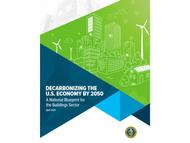DECARBONIZING THE U.S. ECONOMY BY 2050 - Highlighted Article
- Posted On:
- May 9, 2024 at 6:00 AM
- Category
- Energy Policy, Climate Change
From: U.S. Department of Energy
Date: April, 2024
DECARBONIZING THE U.S. ECONOMY BY 2050
A National Blueprint for the Buildings Sector
EXECUTIVE SUMMARY
Residential and commercial buildings are among the largest sources of carbon dioxide and other greenhouse gas (GHG) emissions in the United States, responsible for more than one-third of total U.S. GHG emissions. There are nearly 130 million existing buildings in the United States, with 40 million new homes and 60 billion square feet of commercial floorspace expected to be constructed between now and 2050. Today, most buildings consume large amounts of energy and cause significant climate pollution to meet our basic needs. Buildings account for 74% of U.S. electricity use and building heating and cooling drives peak electricity demand. Moreover, buildings are where electric vehicles (EVs), solar, storage, heat pumps, water heaters, and other distributed energy resources integrate with the electricity system. Consequently, the buildings sector will play a key role in achieving economywide net-zero emissions by 2050.
People spend 90% of their time in buildings and expend substantial sums of money on building energy costs—upwards of $370 billion annually. One in five American households is behind on energy bill payments, with people in economically marginalized communities more likely to face energy insecurity due to high energy costs. Such communities also bear the brunt of healthharming pollution emitted from burning fossil fuels and safety risks from substandard building conditions. Transitioning buildings to clean energy sources and reducing overall energy consumption will therefore address not just climate risks but also the physical and financial well-being of all Americans. (continue reading)
DECARBONIZING THE U.S. ECONOMY BY 2050
A National Blueprint for the Buildings Sector


